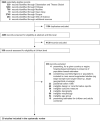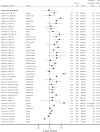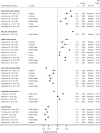Global Trends in Survival From Astrocytic Tumors in Adolescents and Young Adults: A Systematic Review
- PMID: 33134829
- PMCID: PMC7583144
- DOI: 10.1093/jncics/pkaa049
Global Trends in Survival From Astrocytic Tumors in Adolescents and Young Adults: A Systematic Review
Abstract
Background: Brain tumors represent an important cause of cancer-related death in adolescents and young adults. Most are diagnosed in low-income and middle-income countries. We aimed to conduct the first, to our knowledge, systematic review of time trends and geographical variation in survival in this age group.
Methods: We included observational studies describing population-based survival from astrocytic tumors in patients aged 15-39 years. We queried 6 electronic databases from database inception to December 31, 2019. This review is registered with PROSPERO, number CRD42018111981.
Results: Among 5640 retrieved records, 20 studies fulfilled the inclusion criteria. All but 1 study focused on high-income countries. Five-year survival from astrocytoma (broad morphology group) mostly varied between 48.0% and 71.0% (1973-2004) without clear trends or geographic differences. Adolescents with astrocytoma had better outcomes than young adults, but survival values were similar when nonmalignant tumors were excluded. During 2002-2007, 5-year survival for World Health Organization grade I-II tumors was in the range of 72.6%-89.1% in England, Germany, and the United States but lower in Southeastern Europe (59.0%). Five-year survival for anaplastic astrocytoma varied between 39.6% and 55.4% (2002-2007). Five-year survival from glioblastoma was in the range of 14.2%-23.1% (1991-2009).
Conclusions: Survival from astrocytic tumors remained somewhat steady over time, with little change between 1973 and 2009. Survival disparities were difficult to examine, because nearly all the studies were conducted in affluent countries. Studies often adopted the International Classification of Childhood Cancer, which, however, did not allow to accurately describe variation in survival. Larger studies are warranted, including underrepresented populations and providing more recent survival estimates.
© The Author(s) 2020. Published by Oxford University Press.
Figures




Similar articles
-
Global survival trends for brain tumors, by histology: analysis of individual records for 556,237 adults diagnosed in 59 countries during 2000-2014 (CONCORD-3).Neuro Oncol. 2023 Mar 14;25(3):580-592. doi: 10.1093/neuonc/noac217. Neuro Oncol. 2023. PMID: 36355361 Free PMC article.
-
Worldwide Trends in Survival From Common Childhood Brain Tumors: A Systematic Review.J Glob Oncol. 2019 Oct;5:1-25. doi: 10.1200/JGO.19.00140. J Glob Oncol. 2019. PMID: 31682549 Free PMC article.
-
The histology of brain tumors for 67 331 children and 671 085 adults diagnosed in 60 countries during 2000-2014: a global, population-based study (CONCORD-3).Neuro Oncol. 2021 Oct 1;23(10):1765-1776. doi: 10.1093/neuonc/noab067. Neuro Oncol. 2021. PMID: 33738488 Free PMC article.
-
Novel, improved grading system(s) for IDH-mutant astrocytic gliomas.Acta Neuropathol. 2018 Jul;136(1):153-166. doi: 10.1007/s00401-018-1849-4. Epub 2018 Apr 23. Acta Neuropathol. 2018. PMID: 29687258
-
The prevalence of loneliness across 113 countries: systematic review and meta-analysis.BMJ. 2022 Feb 9;376:e067068. doi: 10.1136/bmj-2021-067068. BMJ. 2022. PMID: 35140066 Free PMC article.
Cited by
-
Nutritional Assessment and Management of Patients with Brain Neoplasms Undergoing Neurosurgery: A Systematic Review.Cancers (Basel). 2025 Feb 24;17(5):764. doi: 10.3390/cancers17050764. Cancers (Basel). 2025. PMID: 40075613 Free PMC article. Review.
-
Global survival trends for brain tumors, by histology: analysis of individual records for 556,237 adults diagnosed in 59 countries during 2000-2014 (CONCORD-3).Neuro Oncol. 2023 Mar 14;25(3):580-592. doi: 10.1093/neuonc/noac217. Neuro Oncol. 2023. PMID: 36355361 Free PMC article.
-
Natural Compounds as Promising Adjuvant Agents in The Treatment of Gliomas.Int J Mol Sci. 2022 Mar 20;23(6):3360. doi: 10.3390/ijms23063360. Int J Mol Sci. 2022. PMID: 35328780 Free PMC article. Review.
-
Differential gene expression analysis supports dysregulation of mitochondrial activity as a new perspective for glioblastoma's aggressiveness.Heliyon. 2024 Nov 15;10(22):e40414. doi: 10.1016/j.heliyon.2024.e40414. eCollection 2024 Nov 30. Heliyon. 2024. PMID: 39641080 Free PMC article.
References
-
- International Agency for Research on Cancer. Global Cancer Observatory; Cancer Today. 2018. Available from: http://gco.iarc.fr/today/home. Accessed January 15, 2020.
-
- Fidler MM, Gupta S, Soerjomataram I, Ferlay J, Steliarova-Foucher E, Bray F. Cancer incidence and mortality among young adults aged 20-39 years worldwide in 2012: a population-based study. Lancet Oncol. 2017;18(12):1579–1589. - PubMed
-
- International Atomic Energy Agency. Inequity in Cancer Care: A Global Perspective. Vienna: IAEA (International Atomic Energy Agency; ); 2011.
-
- Coleman MP. Cancer survival: global surveillance will stimulate health policy and improve equity. Lancet. 2014;383(9916):564–573. - PubMed
LinkOut - more resources
Full Text Sources
